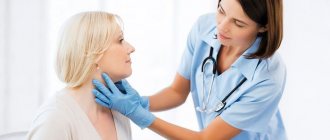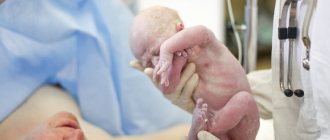A throat smear for flora is a cytological test that allows you to identify viruses, fungi and bacteria found in the pharynx. In this case, both pathogenic microorganisms and habitual inhabitants of mucous membranes that do not pose a threat to health can be detected.
The results of the study are given to the patient a few hours, or less often, days after taking a smear and studying it in the laboratory. A throat swab allows you to identify dysfunctions of internal organs and systems and determine the effectiveness of the therapy used. Bacterioscopy helps the doctor make the correct diagnosis and prescribe the appropriate course of treatment.
What does a throat swab show about flora?
The nose, throat and ears have a constant and abundant microflora, which is home to a fairly large number of different microorganisms.
If their quantity is balanced and does not deviate from the norm, then they do not harm human health. An imbalance of microorganisms can provoke infectious and inflammatory processes. In this case, the doctor prescribes a study of biomaterial from the throat.
Content:
- What does a throat swab show about flora?
- Types of smears on flora
- Indications for taking a throat swab for flora
- Features of preparation for analysis
- Carrying out manipulation
- Obtaining analysis results
Microbiological analysis has many advantages, the main of which are the speed of obtaining results and the speed of manipulation. A smear can detect fungus, bacteria, viruses and protozoan microorganisms.
Bacterioscopy can reveal an increased increase in the number of pathogens. Using analysis, the laboratory assistant determines the number of microorganisms, evaluates their parameters, shape, and location.
The information obtained allows you to determine the condition of internal organs, identify inflammation and pathological changes that occur in a latent form without symptoms. In addition to studying the sample under a microscope, the biomaterial can be sent for bacterial culture for microflora, thanks to which it is possible to learn about the type and genus of fungi and bacteria.
An analysis carried out in the laboratory allows us to determine the causative agent of the infection and its sensitivity to drugs, in particular to antibiotics. The duration of the study to identify microbes and other microorganisms ranges from 7 to 13 days.
Washing the lacunae of the palatine tonsils
Recommended by doctors for chronic tonsillitis, including for the prevention of exacerbations of the disease. It can be carried out with a syringe with a special attachment - a cannula or using a vacuum method.
The palatine tonsils are accumulations of lymphoid tissue in the pharynx; their important anatomical feature is the crypts. Crypts are branching depressions in the tonsils, due to which the area of contact of lymphoid tissue with infectious agents increases and, as a result, the immune response is carried out faster.
Tonsilloliths also form in the crypts - caseous plugs, which are dense formations consisting of desquamated epithelium and food debris. Usually the plugs are small and come out on their own; this process goes unnoticed by humans. In some cases, plugs linger in the crypts, and when bacteria and leukocytes join them, they increase in size and become denser. The presence of tonsillitis is associated with a feeling of discomfort in the throat, sore throat, reflex cough, and very rarely, only in 3% of cases, halitosis (bad breath). Among the normal microflora of crypts, anaerobes stand out separately, producing volatile sulfur compounds; it is because of them that the cork acquires a characteristic unpleasant odor.
It is believed that caseous plugs do not have a negative impact on health, which means they do not pose a danger. Only in Russia and the post-Soviet space is the detection of traffic jams associated with the presence of chronic tonsillitis. In other countries, this disease is classified as persistent inflammation and swelling in the throat, accompanied by pain, in some cases requiring systemic antibacterial therapy.
In our country, doctors usually recommend a course of rinsing, consisting of 5 procedures, which are carried out every other day or less often. This approach is not based on evidence of effectiveness, but on the preferences of a particular specialist, “his personal experience” and the desire of the patient. A wide variety of washing solutions are used - from furatsilin to systemic antibiotics and bacteriophages.
Foreign doctors offer patients to remove plugs themselves in a variety of ways. It has not been proven that a course of washing the tonsils reduces the incidence of tonsillitis. If caseous plugs cause a person significant discomfort, or he or she is bothered by bad breath, it is suggested that you discuss the possibility of tonsillectomy (tonsil removal) with your doctor. Sometimes, unfortunately, this is the only way to get rid of traffic jams. A one-time rinsing of the tonsils is allowed to remove tonsillitis (not during an exacerbation of chronic tonsillitis!), if they cause severe discomfort, including psychological, and the patient is unable to do this on his own.
The therapeutic effect of washing the palatine tonsils in the prevention of exacerbations of chronic tonsillitis has not been proven. There are also no clear recommendations determining the number of procedures.
It is important to know : washing the lacunae of the tonsils is not a therapeutic or preventive procedure.
Types of smears on flora
A vaginal flora smear is taken from three main areas - the vaginal mucosa, the cervix and the urinary canal. The gynecologist sends the woman for analysis:
- for pain in the lower abdomen;
- cystitis;
- burning or itching of the genitals;
- thrush;
- long-term use of medications (antibiotics, hormones).
The study is conducted for those women who are planning to conceive a child.
To conduct a bacterioscopy for flora in men, you will need prostate secretion, scraping from the urethra and sperm. The urologist performs this manipulation during a routine examination. Indications for the procedure include discharge from the urinary canal, suspected infertility, and pain when emptying the bladder.
An analysis of ear flora is prescribed for any type of inflammation of the middle ear, drainage of pus from the ear, painful sensations, or partial hearing loss. The study will show what caused the disease and what medications are most effective in combating this disease. The doctor takes biomaterial from the mucous membrane of the outer part of the ear.
Indications for taking a throat swab for flora
A smear can be prescribed to a patient for a preventive examination, for example, for school, college or work. Other indications for the procedure include:
- angina;
- staphylococcus;
- suspicion of pertussis or meningococcal infection;
- mononucleosis;
- laryngitis;
- abscesses localized near the tonsils;
- frontal sinusitis;
- sinusitis.
The study can be prescribed to women carrying a child to identify hidden infections and changes in the body of the expectant mother. Diseases can complicate the course of pregnancy and become a threat to the life of the fetus.
A throat swab for flora may be prescribed before surgery.
The analysis is necessary for people who come into contact with people sick with contagious infectious and viral diseases for timely detection, treatment and prevention of further spread of the disease.
It is advisable to carry out the study to determine the pathogen that provoked the development of the disease of the ENT organs.
Necessary equipment
Individual protection means
The material collected is infectious and the procedure may generate an aerosol (if sneezing or coughing), so the person performing the swab must wear personal protective equipment: a long-sleeved waterproof gown, gloves, a mask and safety glasses or a face shield (if swabbing the face with suspected SARS-CoV-2 infection, it is best to use an FFP2/FFP3 filter mask [if not available, a surgical mask is acceptable, especially if work is not performed with continuous exposure], a face shield, an additional gown, e.g. non-woven, and double gloves - internal, worn under the cuff, and external ones on the cuff of the robe). The procedure should be carried out in a separate and well-ventilated room. The patient must wear a mask, which he removes immediately before performing the procedure.
Smear collection kit
Before performing the procedure, you should prepare a smear collection kit. The type of microorganism and the planned test determine the type of swab probe and substrate. To collect material for PCR testing, you should use only swab probes with synthetic fiber wound on a plastic rod (others may cause PCR inhibition). Do not use swab probes made from organic materials (eg cotton, wood) or calcium alginate, as they may inhibit PCR. In addition, when taking a smear in the direction of whooping cough, you should not use cotton swabs or rayon (rayon) swabs. Polyester, Dacron or nylon swabs on a plastic shaft are probably universal. On the shaft of the swab probe there is a factory mark on the depth to which it should be inserted, and a narrowing at which it should be broken after lowering it into the test tube.
In case of diagnosis for the presence of SARS-CoV-2, you can use:
1) commercial kits - contain a flexible flocked plastic probe and a tube with virological medium
2) home made kits (for swabs from the throat and nose), containing:
a) sterile flocked or standard plastic swab probes with dacron, viscose or rayon swabs
b) test tubes with a sterile buffered 0.9% NaCl solution in a volume that allows the end of the swab probe to be immersed (Fig. 1).
Picture 1. A - equipment needed to prepare a home made kit: 1 - a needle for drawing up a 0.9% NaCl solution, 2 - a syringe, 3 - a small package with a 0.9% NaCl solution (small packages should be used to avoid contamination of the solution when used) repeated use), 4 - probe-tampon, 5 - test tube. B - 0.9% NaCl solution should be drawn into a syringe under aseptic conditions. B - approximately 1 ml of solution should be poured into a test tube into which, after taking a smear, a swab probe will be placed
Before taking a smear, you should describe the tube in which the swab probe will be placed and stick a code on it (if required; Fig. 2).
Figure -2. Description and sticking of the code on the test tube. The following information must be indicated on the tube: patient’s first and last name, date of birth, date and time of swab collection.
Features of preparation for analysis
To obtain reliable results of a smear on the flora from the throat, you should follow the rules:
- Before manipulation, stop rinsing your mouth with rinses and other solutions.
- 3 days before the test, do not use ointments and oral sprays that contain antimicrobial components and antibiotics.
- You should come to the smear test on an empty stomach: you should not eat or drink water 6-8 hours before the procedure. There is no need to brush your teeth with toothpaste on the day of the test.
Refusal from solutions for rinsing the mouth and medicinal sprays for the throat is necessary due to the fact that most of the microorganisms will be washed out with them, therefore the result of the smear will be false.
Food and drinks can wash away some of the germs or viruses that are on the mucous membrane. The procedure for preparing for a smear test takes no more than 3 days.
Contraindications and complications
There are no absolute contraindications for taking a nasopharyngeal swab. Relative contraindications include: recent trauma or anatomical defects of the facial part of the skull and severe bleeding diathesis - these may prevent the insertion of the probe or increase the risk of local trauma and bleeding. Complications result from local tissue damage (bleeding, pain or discomfort). The procedure may cause coughing and sneezing, and sometimes vomiting (due to irritation of the back of the throat).
Carrying out manipulation
The patient enters the office and sits on the couch. The doctor asks the patient to throw his head back on a special headrest and open his mouth wide.
The specialist presses the patient’s tongue with a wooden or metal oblong spatula, then takes a swab with a cotton tip and collects biomaterial from the mucous membrane of the pharynx. During the manipulation, the person does not feel pain or severe discomfort; only a gag reflex may occur due to the touch of the stick to the back wall of the throat.
The doctor places the resulting sample in a special container or test tube. In laboratory conditions, the material taken will be exposed to different environments in order to determine the presence of microbes, fungi and bacteria.
Depending on the reaction to a certain environment and the behavior of microorganisms during exposure to drugs and antibiotics, the laboratory assistant issues the appropriate research result.
References
- Khaitovich, A.B., Voevodkina, A.Yu. Microbiome and its impact on human health. Crimean Journal of Experimental and Clinical Medicine, 2021. - No. 1. - P. 61-70.
- Krasnova, E.I., Khokhlova, N.I., Evstropov, A.N. and others. Streptococcal infection of the oropharynx: approaches to diagnosis and treatment. Infectious diseases, 2015. - No. 4. - P. 30-36.
- Li, N., Ma, W., Pang, M. et al. The commensal microbiota and viral infection: a comprehensive review. Frontiers in immunology, 2019. - Vol. 10.






